Financial Decision Making Report: Camden Ltd and Alpha Ltd Analysis
VerifiedAdded on 2023/01/11
|11
|3833
|96
Report
AI Summary
This report provides a comprehensive analysis of financial decision-making processes, focusing on two key areas. Firstly, it critically evaluates the roles of the accounting and finance departments within Camden Ltd, a UK-based company, highlighting their importance in managing finances, making investment decisions, and ensuring accurate financial reporting. Secondly, the report delves into a detailed ratio analysis of Alpha Ltd's financial performance, calculating and interpreting key ratios such as Return on Capital Employed (ROCE), Net Profit Margin, Current Ratio, Debtor Collection Period, and Creditor Collection Period for both 2017 and 2018. The analysis provides insights into the company's profitability, efficiency, and solvency, comparing its performance over the two years and drawing conclusions about its financial health and areas for improvement. The report emphasizes the significance of financial ratios as tools for assessing company performance and making informed investment decisions.

Financial Decision Making
1
1
Paraphrase This Document
Need a fresh take? Get an instant paraphrase of this document with our AI Paraphraser
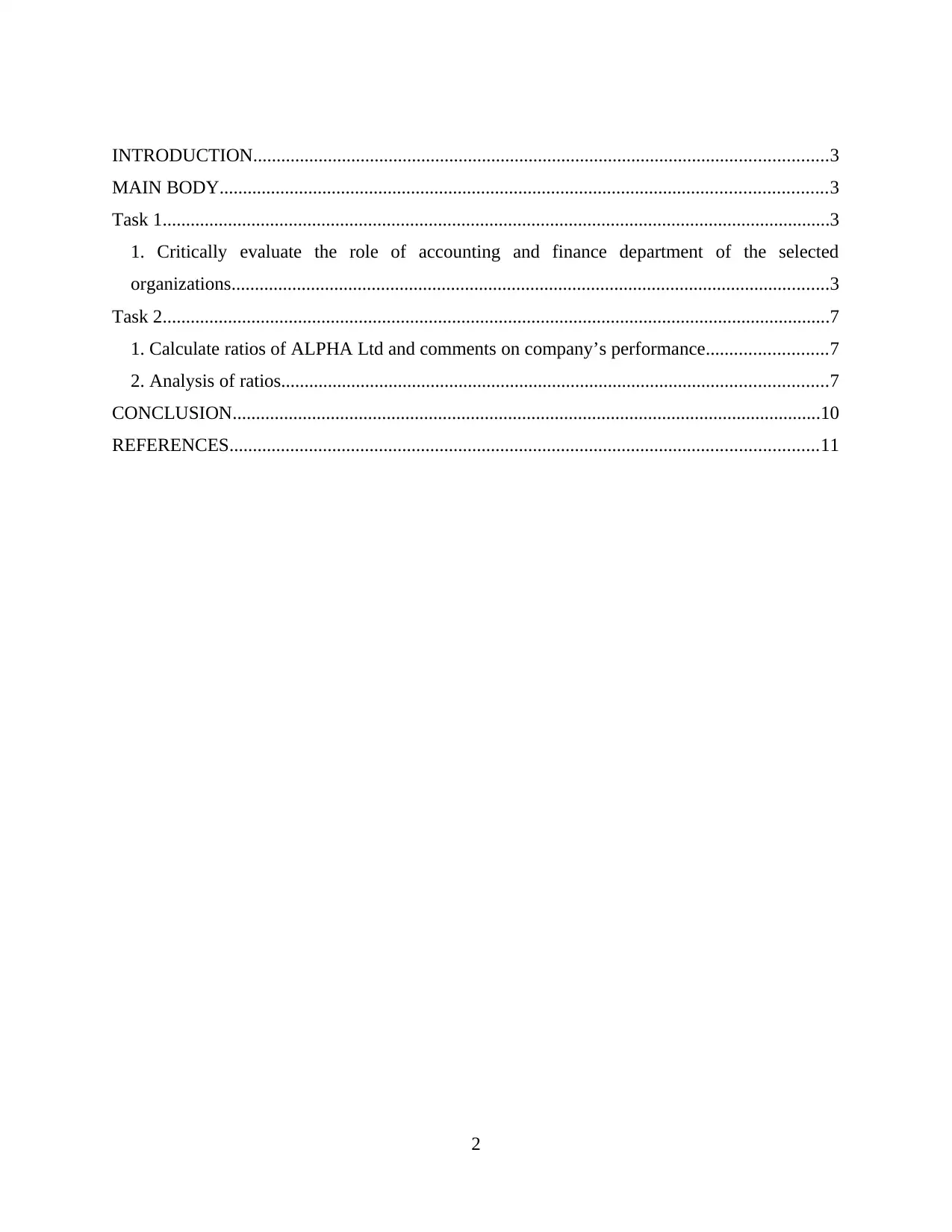
INTRODUCTION...........................................................................................................................3
MAIN BODY..................................................................................................................................3
Task 1...............................................................................................................................................3
1. Critically evaluate the role of accounting and finance department of the selected
organizations................................................................................................................................3
Task 2...............................................................................................................................................7
1. Calculate ratios of ALPHA Ltd and comments on company’s performance..........................7
2. Analysis of ratios.....................................................................................................................7
CONCLUSION..............................................................................................................................10
REFERENCES..............................................................................................................................11
2
MAIN BODY..................................................................................................................................3
Task 1...............................................................................................................................................3
1. Critically evaluate the role of accounting and finance department of the selected
organizations................................................................................................................................3
Task 2...............................................................................................................................................7
1. Calculate ratios of ALPHA Ltd and comments on company’s performance..........................7
2. Analysis of ratios.....................................................................................................................7
CONCLUSION..............................................................................................................................10
REFERENCES..............................................................................................................................11
2
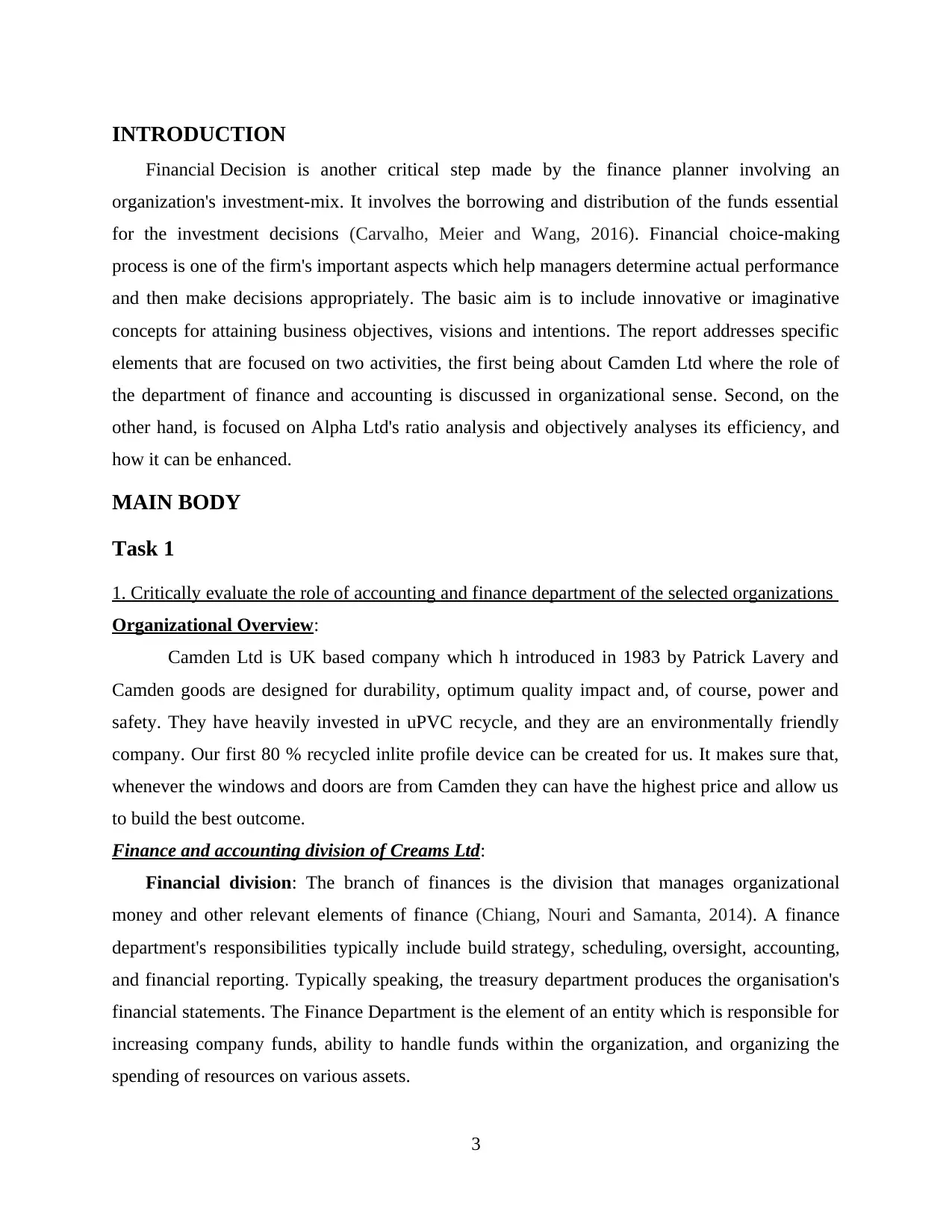
INTRODUCTION
Financial Decision is another critical step made by the finance planner involving an
organization's investment-mix. It involves the borrowing and distribution of the funds essential
for the investment decisions (Carvalho, Meier and Wang, 2016). Financial choice-making
process is one of the firm's important aspects which help managers determine actual performance
and then make decisions appropriately. The basic aim is to include innovative or imaginative
concepts for attaining business objectives, visions and intentions. The report addresses specific
elements that are focused on two activities, the first being about Camden Ltd where the role of
the department of finance and accounting is discussed in organizational sense. Second, on the
other hand, is focused on Alpha Ltd's ratio analysis and objectively analyses its efficiency, and
how it can be enhanced.
MAIN BODY
Task 1
1. Critically evaluate the role of accounting and finance department of the selected organizations
Organizational Overview:
Camden Ltd is UK based company which h introduced in 1983 by Patrick Lavery and
Camden goods are designed for durability, optimum quality impact and, of course, power and
safety. They have heavily invested in uPVC recycle, and they are an environmentally friendly
company. Our first 80 % recycled inlite profile device can be created for us. It makes sure that,
whenever the windows and doors are from Camden they can have the highest price and allow us
to build the best outcome.
Finance and accounting division of Creams Ltd:
Financial division: The branch of finances is the division that manages organizational
money and other relevant elements of finance (Chiang, Nouri and Samanta, 2014). A finance
department's responsibilities typically include build strategy, scheduling, oversight, accounting,
and financial reporting. Typically speaking, the treasury department produces the organisation's
financial statements. The Finance Department is the element of an entity which is responsible for
increasing company funds, ability to handle funds within the organization, and organizing the
spending of resources on various assets.
3
Financial Decision is another critical step made by the finance planner involving an
organization's investment-mix. It involves the borrowing and distribution of the funds essential
for the investment decisions (Carvalho, Meier and Wang, 2016). Financial choice-making
process is one of the firm's important aspects which help managers determine actual performance
and then make decisions appropriately. The basic aim is to include innovative or imaginative
concepts for attaining business objectives, visions and intentions. The report addresses specific
elements that are focused on two activities, the first being about Camden Ltd where the role of
the department of finance and accounting is discussed in organizational sense. Second, on the
other hand, is focused on Alpha Ltd's ratio analysis and objectively analyses its efficiency, and
how it can be enhanced.
MAIN BODY
Task 1
1. Critically evaluate the role of accounting and finance department of the selected organizations
Organizational Overview:
Camden Ltd is UK based company which h introduced in 1983 by Patrick Lavery and
Camden goods are designed for durability, optimum quality impact and, of course, power and
safety. They have heavily invested in uPVC recycle, and they are an environmentally friendly
company. Our first 80 % recycled inlite profile device can be created for us. It makes sure that,
whenever the windows and doors are from Camden they can have the highest price and allow us
to build the best outcome.
Finance and accounting division of Creams Ltd:
Financial division: The branch of finances is the division that manages organizational
money and other relevant elements of finance (Chiang, Nouri and Samanta, 2014). A finance
department's responsibilities typically include build strategy, scheduling, oversight, accounting,
and financial reporting. Typically speaking, the treasury department produces the organisation's
financial statements. The Finance Department is the element of an entity which is responsible for
increasing company funds, ability to handle funds within the organization, and organizing the
spending of resources on various assets.
3
⊘ This is a preview!⊘
Do you want full access?
Subscribe today to unlock all pages.

Trusted by 1+ million students worldwide
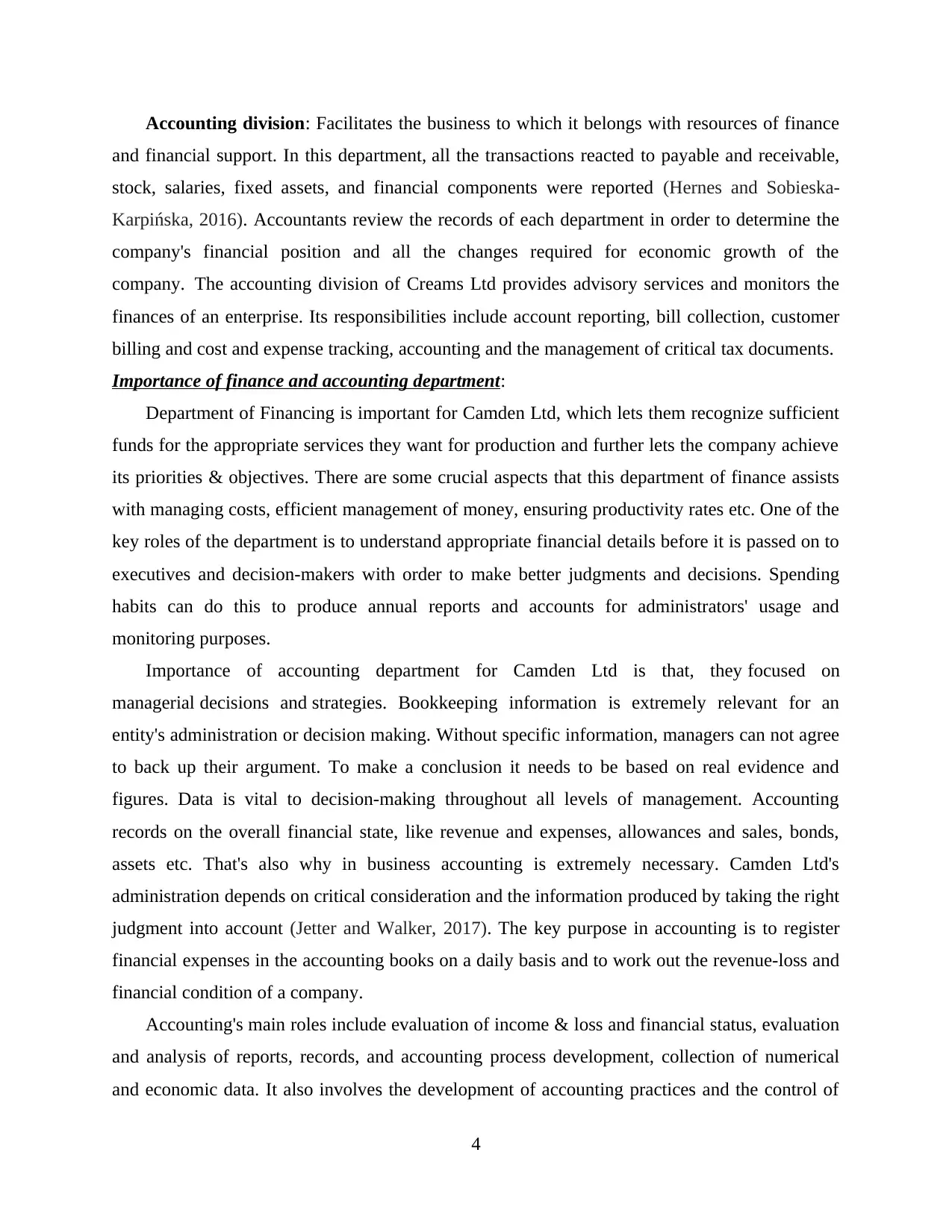
Accounting division: Facilitates the business to which it belongs with resources of finance
and financial support. In this department, all the transactions reacted to payable and receivable,
stock, salaries, fixed assets, and financial components were reported (Hernes and Sobieska-
Karpińska, 2016). Accountants review the records of each department in order to determine the
company's financial position and all the changes required for economic growth of the
company. The accounting division of Creams Ltd provides advisory services and monitors the
finances of an enterprise. Its responsibilities include account reporting, bill collection, customer
billing and cost and expense tracking, accounting and the management of critical tax documents.
Importance of finance and accounting department:
Department of Financing is important for Camden Ltd, which lets them recognize sufficient
funds for the appropriate services they want for production and further lets the company achieve
its priorities & objectives. There are some crucial aspects that this department of finance assists
with managing costs, efficient management of money, ensuring productivity rates etc. One of the
key roles of the department is to understand appropriate financial details before it is passed on to
executives and decision-makers with order to make better judgments and decisions. Spending
habits can do this to produce annual reports and accounts for administrators' usage and
monitoring purposes.
Importance of accounting department for Camden Ltd is that, they focused on
managerial decisions and strategies. Bookkeeping information is extremely relevant for an
entity's administration or decision making. Without specific information, managers can not agree
to back up their argument. To make a conclusion it needs to be based on real evidence and
figures. Data is vital to decision-making throughout all levels of management. Accounting
records on the overall financial state, like revenue and expenses, allowances and sales, bonds,
assets etc. That's also why in business accounting is extremely necessary. Camden Ltd's
administration depends on critical consideration and the information produced by taking the right
judgment into account (Jetter and Walker, 2017). The key purpose in accounting is to register
financial expenses in the accounting books on a daily basis and to work out the revenue-loss and
financial condition of a company.
Accounting's main roles include evaluation of income & loss and financial status, evaluation
and analysis of reports, records, and accounting process development, collection of numerical
and economic data. It also involves the development of accounting practices and the control of
4
and financial support. In this department, all the transactions reacted to payable and receivable,
stock, salaries, fixed assets, and financial components were reported (Hernes and Sobieska-
Karpińska, 2016). Accountants review the records of each department in order to determine the
company's financial position and all the changes required for economic growth of the
company. The accounting division of Creams Ltd provides advisory services and monitors the
finances of an enterprise. Its responsibilities include account reporting, bill collection, customer
billing and cost and expense tracking, accounting and the management of critical tax documents.
Importance of finance and accounting department:
Department of Financing is important for Camden Ltd, which lets them recognize sufficient
funds for the appropriate services they want for production and further lets the company achieve
its priorities & objectives. There are some crucial aspects that this department of finance assists
with managing costs, efficient management of money, ensuring productivity rates etc. One of the
key roles of the department is to understand appropriate financial details before it is passed on to
executives and decision-makers with order to make better judgments and decisions. Spending
habits can do this to produce annual reports and accounts for administrators' usage and
monitoring purposes.
Importance of accounting department for Camden Ltd is that, they focused on
managerial decisions and strategies. Bookkeeping information is extremely relevant for an
entity's administration or decision making. Without specific information, managers can not agree
to back up their argument. To make a conclusion it needs to be based on real evidence and
figures. Data is vital to decision-making throughout all levels of management. Accounting
records on the overall financial state, like revenue and expenses, allowances and sales, bonds,
assets etc. That's also why in business accounting is extremely necessary. Camden Ltd's
administration depends on critical consideration and the information produced by taking the right
judgment into account (Jetter and Walker, 2017). The key purpose in accounting is to register
financial expenses in the accounting books on a daily basis and to work out the revenue-loss and
financial condition of a company.
Accounting's main roles include evaluation of income & loss and financial status, evaluation
and analysis of reports, records, and accounting process development, collection of numerical
and economic data. It also involves the development of accounting practices and the control of
4
Paraphrase This Document
Need a fresh take? Get an instant paraphrase of this document with our AI Paraphraser
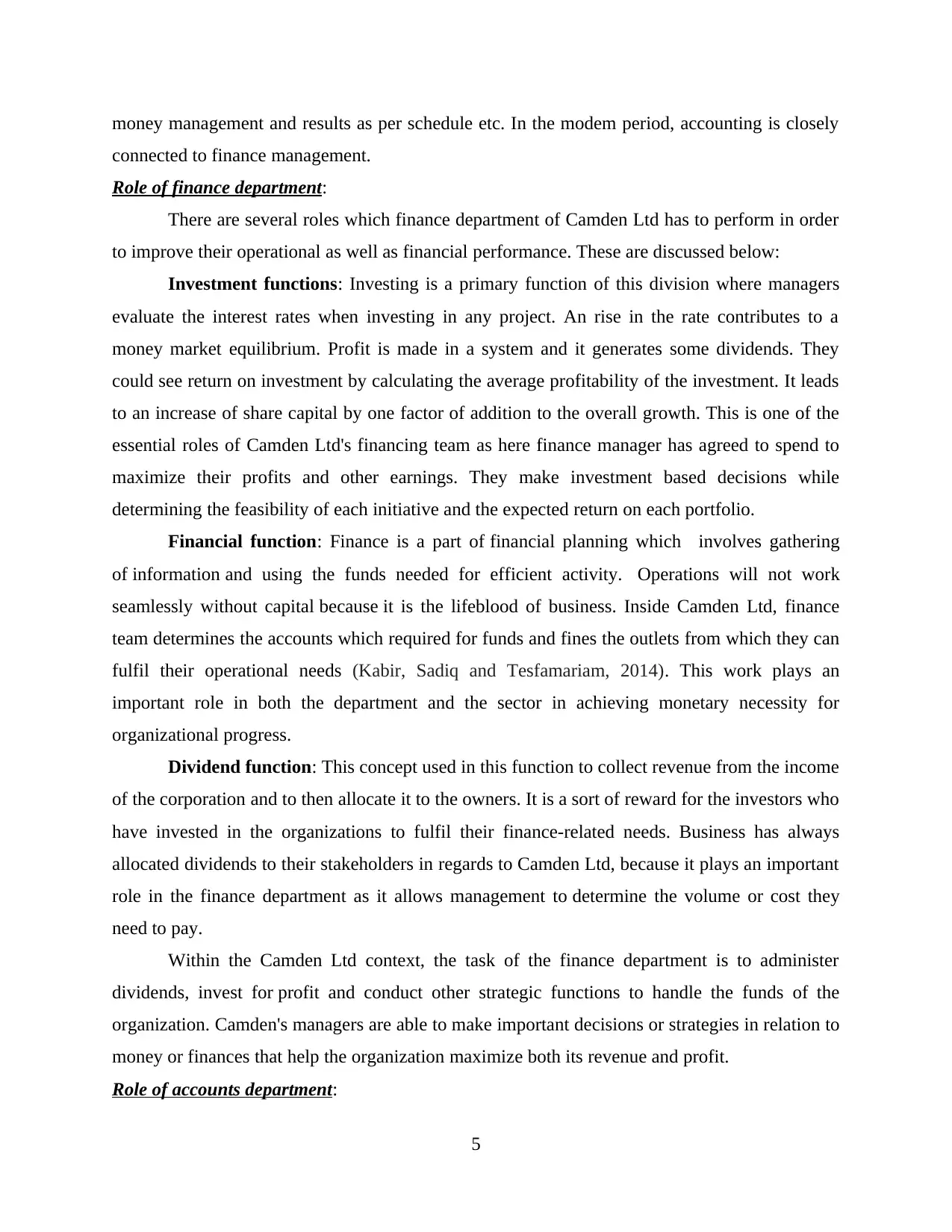
money management and results as per schedule etc. In the modem period, accounting is closely
connected to finance management.
Role of finance department:
There are several roles which finance department of Camden Ltd has to perform in order
to improve their operational as well as financial performance. These are discussed below:
Investment functions: Investing is a primary function of this division where managers
evaluate the interest rates when investing in any project. An rise in the rate contributes to a
money market equilibrium. Profit is made in a system and it generates some dividends. They
could see return on investment by calculating the average profitability of the investment. It leads
to an increase of share capital by one factor of addition to the overall growth. This is one of the
essential roles of Camden Ltd's financing team as here finance manager has agreed to spend to
maximize their profits and other earnings. They make investment based decisions while
determining the feasibility of each initiative and the expected return on each portfolio.
Financial function: Finance is a part of financial planning which involves gathering
of information and using the funds needed for efficient activity. Operations will not work
seamlessly without capital because it is the lifeblood of business. Inside Camden Ltd, finance
team determines the accounts which required for funds and fines the outlets from which they can
fulfil their operational needs (Kabir, Sadiq and Tesfamariam, 2014). This work plays an
important role in both the department and the sector in achieving monetary necessity for
organizational progress.
Dividend function: This concept used in this function to collect revenue from the income
of the corporation and to then allocate it to the owners. It is a sort of reward for the investors who
have invested in the organizations to fulfil their finance-related needs. Business has always
allocated dividends to their stakeholders in regards to Camden Ltd, because it plays an important
role in the finance department as it allows management to determine the volume or cost they
need to pay.
Within the Camden Ltd context, the task of the finance department is to administer
dividends, invest for profit and conduct other strategic functions to handle the funds of the
organization. Camden's managers are able to make important decisions or strategies in relation to
money or finances that help the organization maximize both its revenue and profit.
Role of accounts department:
5
connected to finance management.
Role of finance department:
There are several roles which finance department of Camden Ltd has to perform in order
to improve their operational as well as financial performance. These are discussed below:
Investment functions: Investing is a primary function of this division where managers
evaluate the interest rates when investing in any project. An rise in the rate contributes to a
money market equilibrium. Profit is made in a system and it generates some dividends. They
could see return on investment by calculating the average profitability of the investment. It leads
to an increase of share capital by one factor of addition to the overall growth. This is one of the
essential roles of Camden Ltd's financing team as here finance manager has agreed to spend to
maximize their profits and other earnings. They make investment based decisions while
determining the feasibility of each initiative and the expected return on each portfolio.
Financial function: Finance is a part of financial planning which involves gathering
of information and using the funds needed for efficient activity. Operations will not work
seamlessly without capital because it is the lifeblood of business. Inside Camden Ltd, finance
team determines the accounts which required for funds and fines the outlets from which they can
fulfil their operational needs (Kabir, Sadiq and Tesfamariam, 2014). This work plays an
important role in both the department and the sector in achieving monetary necessity for
organizational progress.
Dividend function: This concept used in this function to collect revenue from the income
of the corporation and to then allocate it to the owners. It is a sort of reward for the investors who
have invested in the organizations to fulfil their finance-related needs. Business has always
allocated dividends to their stakeholders in regards to Camden Ltd, because it plays an important
role in the finance department as it allows management to determine the volume or cost they
need to pay.
Within the Camden Ltd context, the task of the finance department is to administer
dividends, invest for profit and conduct other strategic functions to handle the funds of the
organization. Camden's managers are able to make important decisions or strategies in relation to
money or finances that help the organization maximize both its revenue and profit.
Role of accounts department:
5
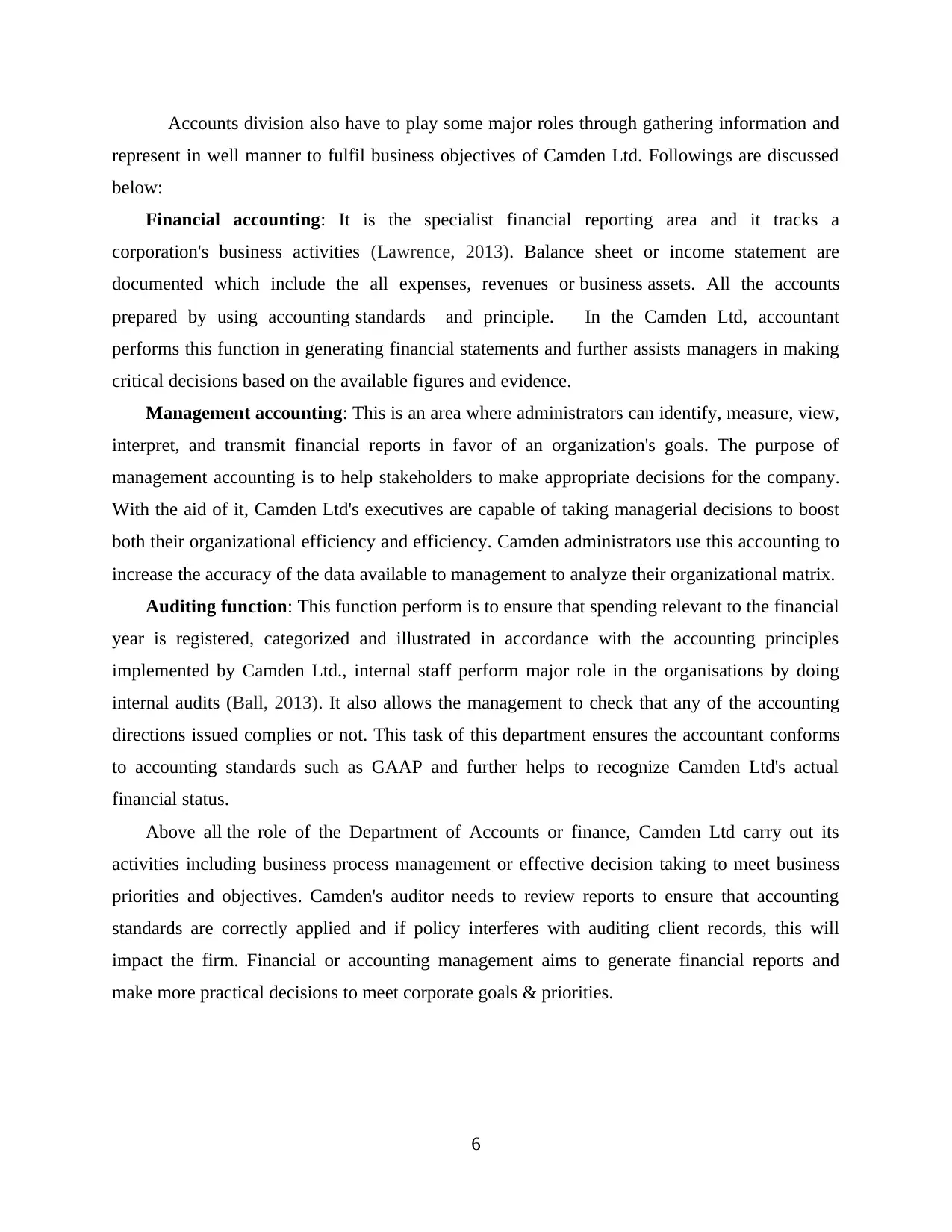
Accounts division also have to play some major roles through gathering information and
represent in well manner to fulfil business objectives of Camden Ltd. Followings are discussed
below:
Financial accounting: It is the specialist financial reporting area and it tracks a
corporation's business activities (Lawrence, 2013). Balance sheet or income statement are
documented which include the all expenses, revenues or business assets. All the accounts
prepared by using accounting standards and principle. In the Camden Ltd, accountant
performs this function in generating financial statements and further assists managers in making
critical decisions based on the available figures and evidence.
Management accounting: This is an area where administrators can identify, measure, view,
interpret, and transmit financial reports in favor of an organization's goals. The purpose of
management accounting is to help stakeholders to make appropriate decisions for the company.
With the aid of it, Camden Ltd's executives are capable of taking managerial decisions to boost
both their organizational efficiency and efficiency. Camden administrators use this accounting to
increase the accuracy of the data available to management to analyze their organizational matrix.
Auditing function: This function perform is to ensure that spending relevant to the financial
year is registered, categorized and illustrated in accordance with the accounting principles
implemented by Camden Ltd., internal staff perform major role in the organisations by doing
internal audits (Ball, 2013). It also allows the management to check that any of the accounting
directions issued complies or not. This task of this department ensures the accountant conforms
to accounting standards such as GAAP and further helps to recognize Camden Ltd's actual
financial status.
Above all the role of the Department of Accounts or finance, Camden Ltd carry out its
activities including business process management or effective decision taking to meet business
priorities and objectives. Camden's auditor needs to review reports to ensure that accounting
standards are correctly applied and if policy interferes with auditing client records, this will
impact the firm. Financial or accounting management aims to generate financial reports and
make more practical decisions to meet corporate goals & priorities.
6
represent in well manner to fulfil business objectives of Camden Ltd. Followings are discussed
below:
Financial accounting: It is the specialist financial reporting area and it tracks a
corporation's business activities (Lawrence, 2013). Balance sheet or income statement are
documented which include the all expenses, revenues or business assets. All the accounts
prepared by using accounting standards and principle. In the Camden Ltd, accountant
performs this function in generating financial statements and further assists managers in making
critical decisions based on the available figures and evidence.
Management accounting: This is an area where administrators can identify, measure, view,
interpret, and transmit financial reports in favor of an organization's goals. The purpose of
management accounting is to help stakeholders to make appropriate decisions for the company.
With the aid of it, Camden Ltd's executives are capable of taking managerial decisions to boost
both their organizational efficiency and efficiency. Camden administrators use this accounting to
increase the accuracy of the data available to management to analyze their organizational matrix.
Auditing function: This function perform is to ensure that spending relevant to the financial
year is registered, categorized and illustrated in accordance with the accounting principles
implemented by Camden Ltd., internal staff perform major role in the organisations by doing
internal audits (Ball, 2013). It also allows the management to check that any of the accounting
directions issued complies or not. This task of this department ensures the accountant conforms
to accounting standards such as GAAP and further helps to recognize Camden Ltd's actual
financial status.
Above all the role of the Department of Accounts or finance, Camden Ltd carry out its
activities including business process management or effective decision taking to meet business
priorities and objectives. Camden's auditor needs to review reports to ensure that accounting
standards are correctly applied and if policy interferes with auditing client records, this will
impact the firm. Financial or accounting management aims to generate financial reports and
make more practical decisions to meet corporate goals & priorities.
6
⊘ This is a preview!⊘
Do you want full access?
Subscribe today to unlock all pages.

Trusted by 1+ million students worldwide
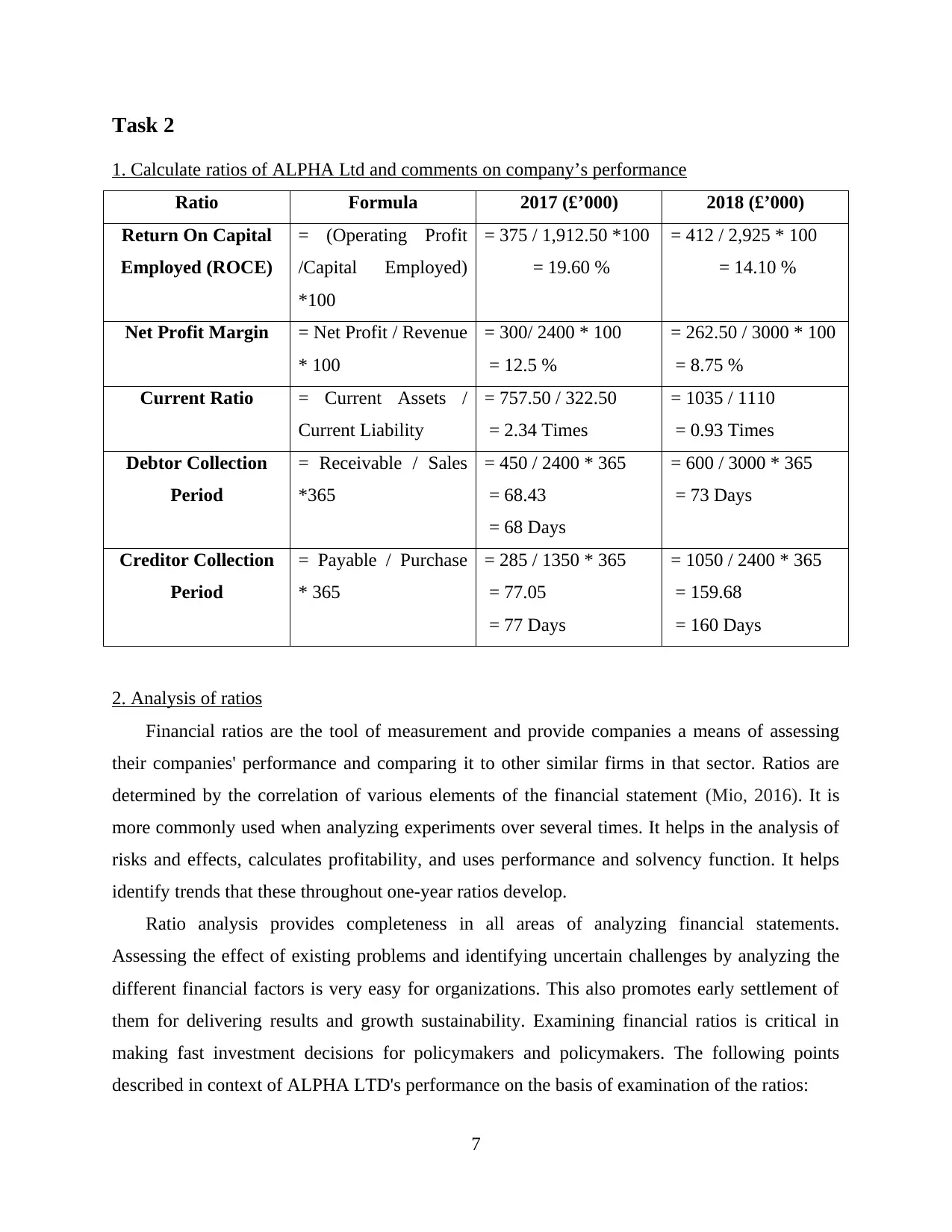
Task 2
1. Calculate ratios of ALPHA Ltd and comments on company’s performance
Ratio Formula 2017 (£’000) 2018 (£’000)
Return On Capital
Employed (ROCE)
= (Operating Profit
/Capital Employed)
*100
= 375 / 1,912.50 *100
= 19.60 %
= 412 / 2,925 * 100
= 14.10 %
Net Profit Margin = Net Profit / Revenue
* 100
= 300/ 2400 * 100
= 12.5 %
= 262.50 / 3000 * 100
= 8.75 %
Current Ratio = Current Assets /
Current Liability
= 757.50 / 322.50
= 2.34 Times
= 1035 / 1110
= 0.93 Times
Debtor Collection
Period
= Receivable / Sales
*365
= 450 / 2400 * 365
= 68.43
= 68 Days
= 600 / 3000 * 365
= 73 Days
Creditor Collection
Period
= Payable / Purchase
* 365
= 285 / 1350 * 365
= 77.05
= 77 Days
= 1050 / 2400 * 365
= 159.68
= 160 Days
2. Analysis of ratios
Financial ratios are the tool of measurement and provide companies a means of assessing
their companies' performance and comparing it to other similar firms in that sector. Ratios are
determined by the correlation of various elements of the financial statement (Mio, 2016). It is
more commonly used when analyzing experiments over several times. It helps in the analysis of
risks and effects, calculates profitability, and uses performance and solvency function. It helps
identify trends that these throughout one-year ratios develop.
Ratio analysis provides completeness in all areas of analyzing financial statements.
Assessing the effect of existing problems and identifying uncertain challenges by analyzing the
different financial factors is very easy for organizations. This also promotes early settlement of
them for delivering results and growth sustainability. Examining financial ratios is critical in
making fast investment decisions for policymakers and policymakers. The following points
described in context of ALPHA LTD's performance on the basis of examination of the ratios:
7
1. Calculate ratios of ALPHA Ltd and comments on company’s performance
Ratio Formula 2017 (£’000) 2018 (£’000)
Return On Capital
Employed (ROCE)
= (Operating Profit
/Capital Employed)
*100
= 375 / 1,912.50 *100
= 19.60 %
= 412 / 2,925 * 100
= 14.10 %
Net Profit Margin = Net Profit / Revenue
* 100
= 300/ 2400 * 100
= 12.5 %
= 262.50 / 3000 * 100
= 8.75 %
Current Ratio = Current Assets /
Current Liability
= 757.50 / 322.50
= 2.34 Times
= 1035 / 1110
= 0.93 Times
Debtor Collection
Period
= Receivable / Sales
*365
= 450 / 2400 * 365
= 68.43
= 68 Days
= 600 / 3000 * 365
= 73 Days
Creditor Collection
Period
= Payable / Purchase
* 365
= 285 / 1350 * 365
= 77.05
= 77 Days
= 1050 / 2400 * 365
= 159.68
= 160 Days
2. Analysis of ratios
Financial ratios are the tool of measurement and provide companies a means of assessing
their companies' performance and comparing it to other similar firms in that sector. Ratios are
determined by the correlation of various elements of the financial statement (Mio, 2016). It is
more commonly used when analyzing experiments over several times. It helps in the analysis of
risks and effects, calculates profitability, and uses performance and solvency function. It helps
identify trends that these throughout one-year ratios develop.
Ratio analysis provides completeness in all areas of analyzing financial statements.
Assessing the effect of existing problems and identifying uncertain challenges by analyzing the
different financial factors is very easy for organizations. This also promotes early settlement of
them for delivering results and growth sustainability. Examining financial ratios is critical in
making fast investment decisions for policymakers and policymakers. The following points
described in context of ALPHA LTD's performance on the basis of examination of the ratios:
7
Paraphrase This Document
Need a fresh take? Get an instant paraphrase of this document with our AI Paraphraser
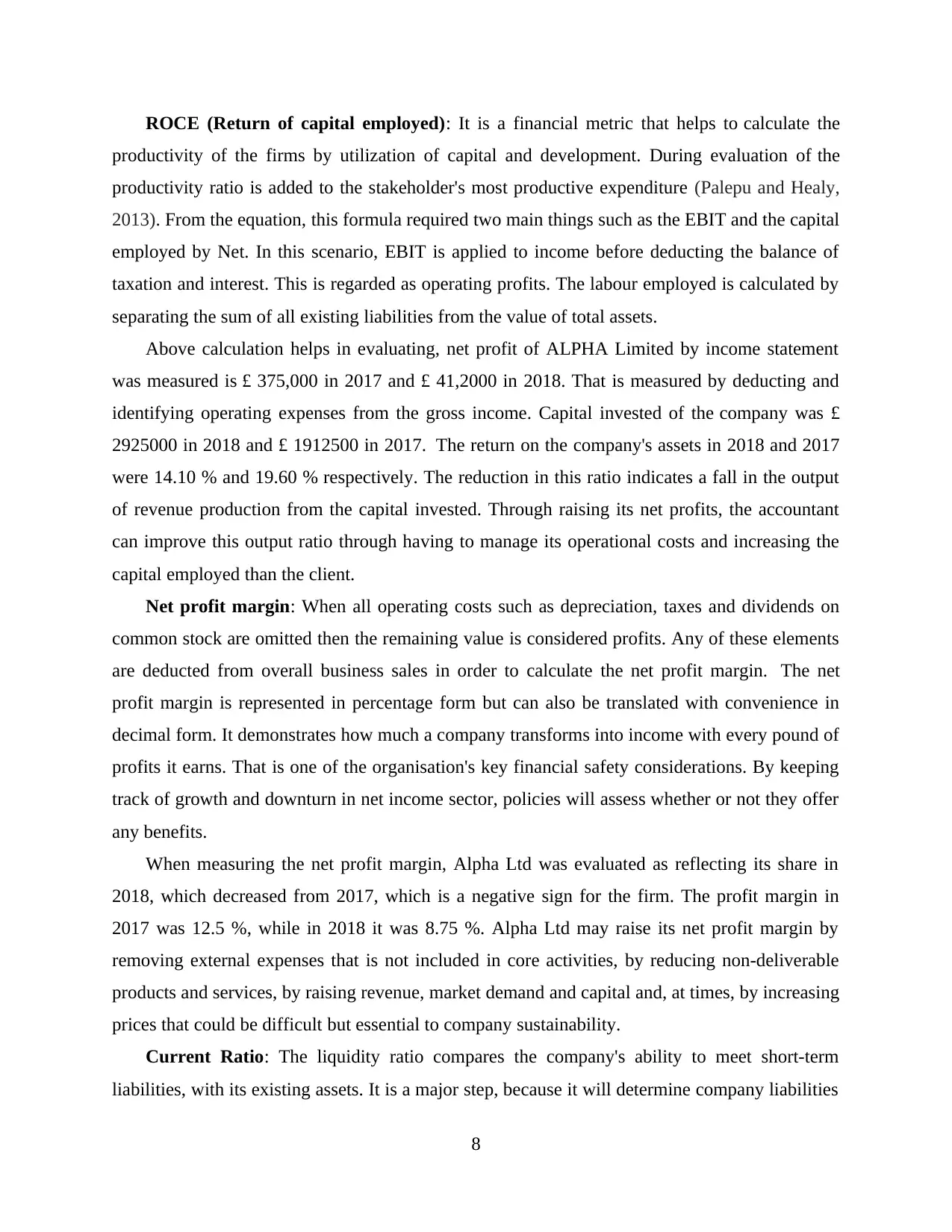
ROCE (Return of capital employed): It is a financial metric that helps to calculate the
productivity of the firms by utilization of capital and development. During evaluation of the
productivity ratio is added to the stakeholder's most productive expenditure (Palepu and Healy,
2013). From the equation, this formula required two main things such as the EBIT and the capital
employed by Net. In this scenario, EBIT is applied to income before deducting the balance of
taxation and interest. This is regarded as operating profits. The labour employed is calculated by
separating the sum of all existing liabilities from the value of total assets.
Above calculation helps in evaluating, net profit of ALPHA Limited by income statement
was measured is £ 375,000 in 2017 and £ 41,2000 in 2018. That is measured by deducting and
identifying operating expenses from the gross income. Capital invested of the company was £
2925000 in 2018 and £ 1912500 in 2017. The return on the company's assets in 2018 and 2017
were 14.10 % and 19.60 % respectively. The reduction in this ratio indicates a fall in the output
of revenue production from the capital invested. Through raising its net profits, the accountant
can improve this output ratio through having to manage its operational costs and increasing the
capital employed than the client.
Net profit margin: When all operating costs such as depreciation, taxes and dividends on
common stock are omitted then the remaining value is considered profits. Any of these elements
are deducted from overall business sales in order to calculate the net profit margin. The net
profit margin is represented in percentage form but can also be translated with convenience in
decimal form. It demonstrates how much a company transforms into income with every pound of
profits it earns. That is one of the organisation's key financial safety considerations. By keeping
track of growth and downturn in net income sector, policies will assess whether or not they offer
any benefits.
When measuring the net profit margin, Alpha Ltd was evaluated as reflecting its share in
2018, which decreased from 2017, which is a negative sign for the firm. The profit margin in
2017 was 12.5 %, while in 2018 it was 8.75 %. Alpha Ltd may raise its net profit margin by
removing external expenses that is not included in core activities, by reducing non-deliverable
products and services, by raising revenue, market demand and capital and, at times, by increasing
prices that could be difficult but essential to company sustainability.
Current Ratio: The liquidity ratio compares the company's ability to meet short-term
liabilities, with its existing assets. It is a major step, because it will determine company liabilities
8
productivity of the firms by utilization of capital and development. During evaluation of the
productivity ratio is added to the stakeholder's most productive expenditure (Palepu and Healy,
2013). From the equation, this formula required two main things such as the EBIT and the capital
employed by Net. In this scenario, EBIT is applied to income before deducting the balance of
taxation and interest. This is regarded as operating profits. The labour employed is calculated by
separating the sum of all existing liabilities from the value of total assets.
Above calculation helps in evaluating, net profit of ALPHA Limited by income statement
was measured is £ 375,000 in 2017 and £ 41,2000 in 2018. That is measured by deducting and
identifying operating expenses from the gross income. Capital invested of the company was £
2925000 in 2018 and £ 1912500 in 2017. The return on the company's assets in 2018 and 2017
were 14.10 % and 19.60 % respectively. The reduction in this ratio indicates a fall in the output
of revenue production from the capital invested. Through raising its net profits, the accountant
can improve this output ratio through having to manage its operational costs and increasing the
capital employed than the client.
Net profit margin: When all operating costs such as depreciation, taxes and dividends on
common stock are omitted then the remaining value is considered profits. Any of these elements
are deducted from overall business sales in order to calculate the net profit margin. The net
profit margin is represented in percentage form but can also be translated with convenience in
decimal form. It demonstrates how much a company transforms into income with every pound of
profits it earns. That is one of the organisation's key financial safety considerations. By keeping
track of growth and downturn in net income sector, policies will assess whether or not they offer
any benefits.
When measuring the net profit margin, Alpha Ltd was evaluated as reflecting its share in
2018, which decreased from 2017, which is a negative sign for the firm. The profit margin in
2017 was 12.5 %, while in 2018 it was 8.75 %. Alpha Ltd may raise its net profit margin by
removing external expenses that is not included in core activities, by reducing non-deliverable
products and services, by raising revenue, market demand and capital and, at times, by increasing
prices that could be difficult but essential to company sustainability.
Current Ratio: The liquidity ratio compares the company's ability to meet short-term
liabilities, with its existing assets. It is a major step, because it will determine company liabilities
8
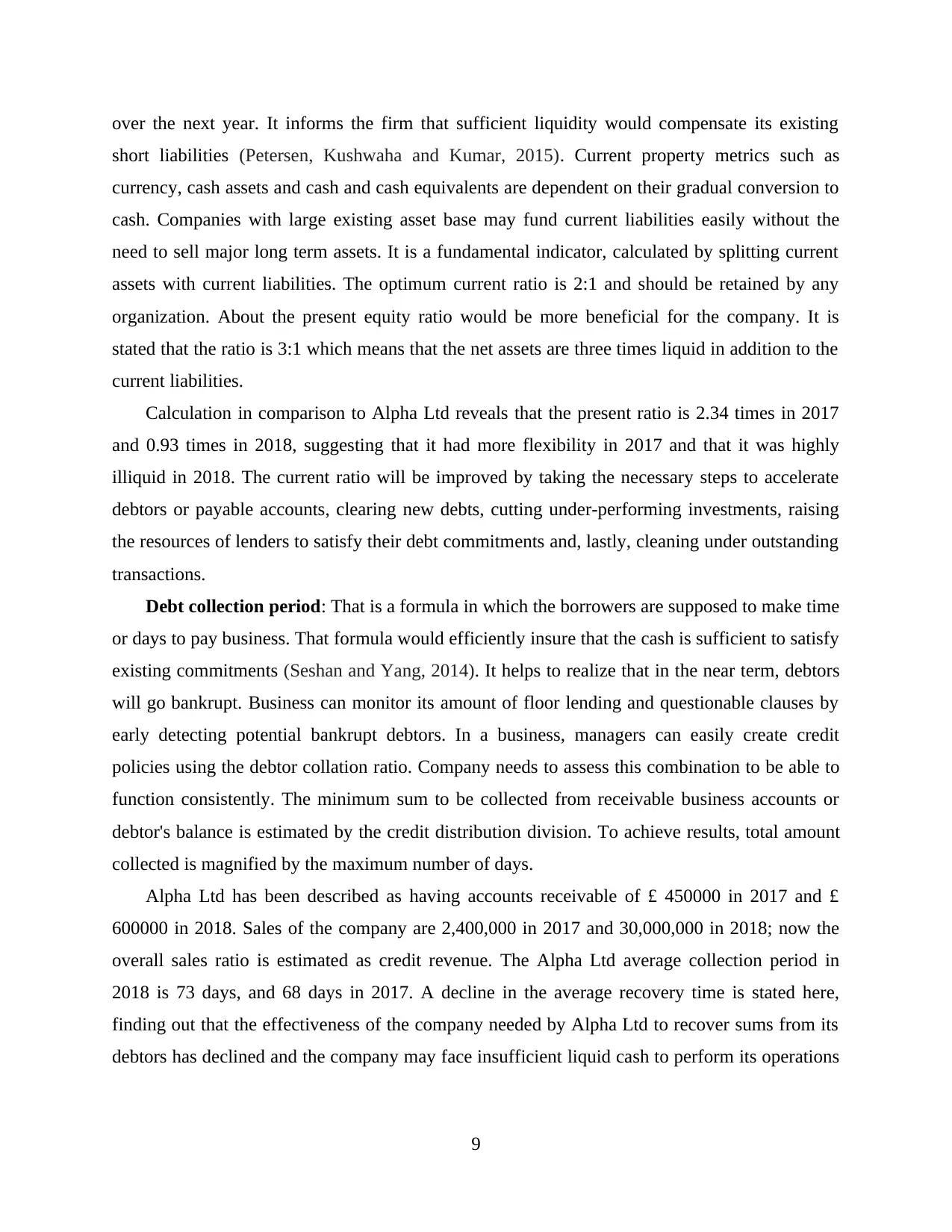
over the next year. It informs the firm that sufficient liquidity would compensate its existing
short liabilities (Petersen, Kushwaha and Kumar, 2015). Current property metrics such as
currency, cash assets and cash and cash equivalents are dependent on their gradual conversion to
cash. Companies with large existing asset base may fund current liabilities easily without the
need to sell major long term assets. It is a fundamental indicator, calculated by splitting current
assets with current liabilities. The optimum current ratio is 2:1 and should be retained by any
organization. About the present equity ratio would be more beneficial for the company. It is
stated that the ratio is 3:1 which means that the net assets are three times liquid in addition to the
current liabilities.
Calculation in comparison to Alpha Ltd reveals that the present ratio is 2.34 times in 2017
and 0.93 times in 2018, suggesting that it had more flexibility in 2017 and that it was highly
illiquid in 2018. The current ratio will be improved by taking the necessary steps to accelerate
debtors or payable accounts, clearing new debts, cutting under-performing investments, raising
the resources of lenders to satisfy their debt commitments and, lastly, cleaning under outstanding
transactions.
Debt collection period: That is a formula in which the borrowers are supposed to make time
or days to pay business. That formula would efficiently insure that the cash is sufficient to satisfy
existing commitments (Seshan and Yang, 2014). It helps to realize that in the near term, debtors
will go bankrupt. Business can monitor its amount of floor lending and questionable clauses by
early detecting potential bankrupt debtors. In a business, managers can easily create credit
policies using the debtor collation ratio. Company needs to assess this combination to be able to
function consistently. The minimum sum to be collected from receivable business accounts or
debtor's balance is estimated by the credit distribution division. To achieve results, total amount
collected is magnified by the maximum number of days.
Alpha Ltd has been described as having accounts receivable of £ 450000 in 2017 and £
600000 in 2018. Sales of the company are 2,400,000 in 2017 and 30,000,000 in 2018; now the
overall sales ratio is estimated as credit revenue. The Alpha Ltd average collection period in
2018 is 73 days, and 68 days in 2017. A decline in the average recovery time is stated here,
finding out that the effectiveness of the company needed by Alpha Ltd to recover sums from its
debtors has declined and the company may face insufficient liquid cash to perform its operations
9
short liabilities (Petersen, Kushwaha and Kumar, 2015). Current property metrics such as
currency, cash assets and cash and cash equivalents are dependent on their gradual conversion to
cash. Companies with large existing asset base may fund current liabilities easily without the
need to sell major long term assets. It is a fundamental indicator, calculated by splitting current
assets with current liabilities. The optimum current ratio is 2:1 and should be retained by any
organization. About the present equity ratio would be more beneficial for the company. It is
stated that the ratio is 3:1 which means that the net assets are three times liquid in addition to the
current liabilities.
Calculation in comparison to Alpha Ltd reveals that the present ratio is 2.34 times in 2017
and 0.93 times in 2018, suggesting that it had more flexibility in 2017 and that it was highly
illiquid in 2018. The current ratio will be improved by taking the necessary steps to accelerate
debtors or payable accounts, clearing new debts, cutting under-performing investments, raising
the resources of lenders to satisfy their debt commitments and, lastly, cleaning under outstanding
transactions.
Debt collection period: That is a formula in which the borrowers are supposed to make time
or days to pay business. That formula would efficiently insure that the cash is sufficient to satisfy
existing commitments (Seshan and Yang, 2014). It helps to realize that in the near term, debtors
will go bankrupt. Business can monitor its amount of floor lending and questionable clauses by
early detecting potential bankrupt debtors. In a business, managers can easily create credit
policies using the debtor collation ratio. Company needs to assess this combination to be able to
function consistently. The minimum sum to be collected from receivable business accounts or
debtor's balance is estimated by the credit distribution division. To achieve results, total amount
collected is magnified by the maximum number of days.
Alpha Ltd has been described as having accounts receivable of £ 450000 in 2017 and £
600000 in 2018. Sales of the company are 2,400,000 in 2017 and 30,000,000 in 2018; now the
overall sales ratio is estimated as credit revenue. The Alpha Ltd average collection period in
2018 is 73 days, and 68 days in 2017. A decline in the average recovery time is stated here,
finding out that the effectiveness of the company needed by Alpha Ltd to recover sums from its
debtors has declined and the company may face insufficient liquid cash to perform its operations
9
⊘ This is a preview!⊘
Do you want full access?
Subscribe today to unlock all pages.

Trusted by 1+ million students worldwide
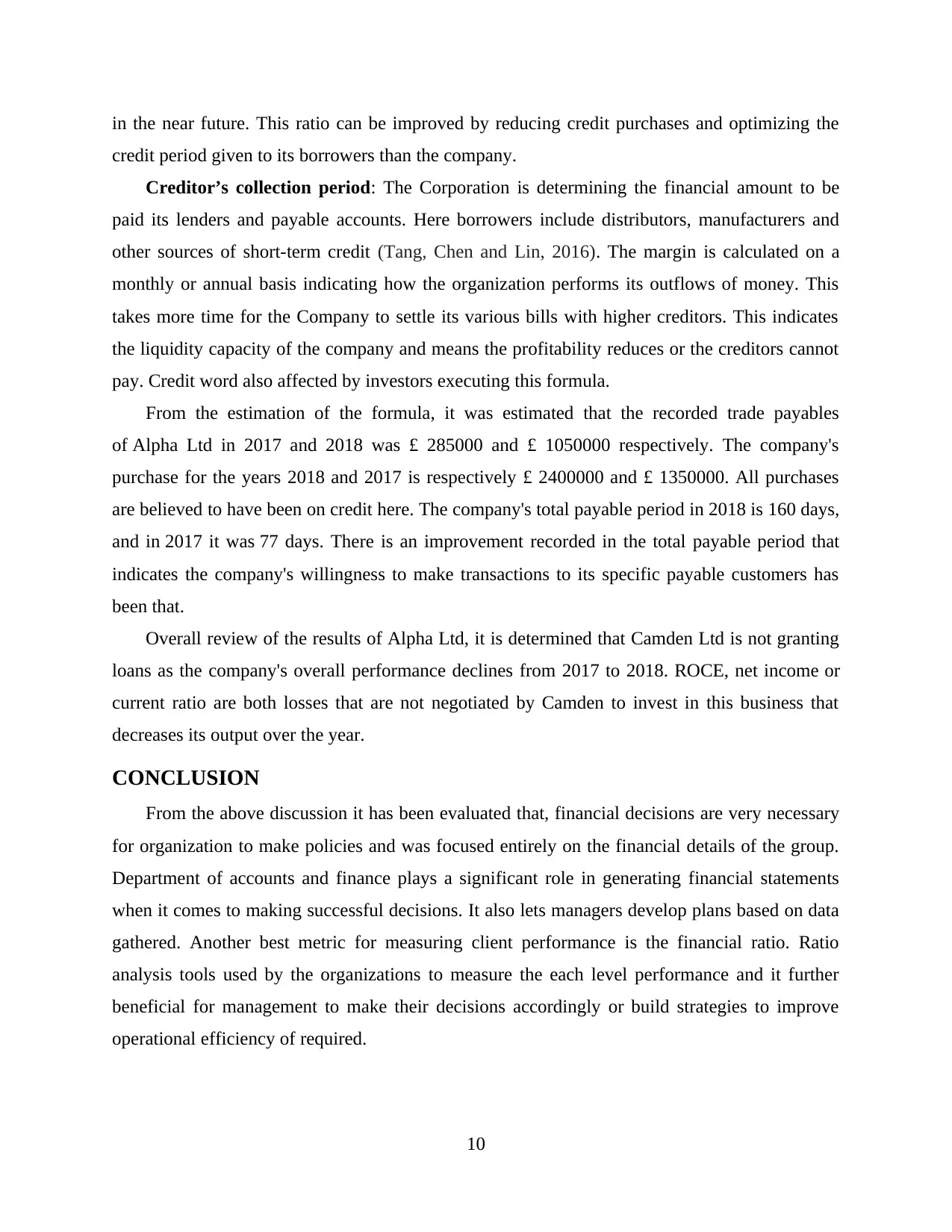
in the near future. This ratio can be improved by reducing credit purchases and optimizing the
credit period given to its borrowers than the company.
Creditor’s collection period: The Corporation is determining the financial amount to be
paid its lenders and payable accounts. Here borrowers include distributors, manufacturers and
other sources of short-term credit (Tang, Chen and Lin, 2016). The margin is calculated on a
monthly or annual basis indicating how the organization performs its outflows of money. This
takes more time for the Company to settle its various bills with higher creditors. This indicates
the liquidity capacity of the company and means the profitability reduces or the creditors cannot
pay. Credit word also affected by investors executing this formula.
From the estimation of the formula, it was estimated that the recorded trade payables
of Alpha Ltd in 2017 and 2018 was £ 285000 and £ 1050000 respectively. The company's
purchase for the years 2018 and 2017 is respectively £ 2400000 and £ 1350000. All purchases
are believed to have been on credit here. The company's total payable period in 2018 is 160 days,
and in 2017 it was 77 days. There is an improvement recorded in the total payable period that
indicates the company's willingness to make transactions to its specific payable customers has
been that.
Overall review of the results of Alpha Ltd, it is determined that Camden Ltd is not granting
loans as the company's overall performance declines from 2017 to 2018. ROCE, net income or
current ratio are both losses that are not negotiated by Camden to invest in this business that
decreases its output over the year.
CONCLUSION
From the above discussion it has been evaluated that, financial decisions are very necessary
for organization to make policies and was focused entirely on the financial details of the group.
Department of accounts and finance plays a significant role in generating financial statements
when it comes to making successful decisions. It also lets managers develop plans based on data
gathered. Another best metric for measuring client performance is the financial ratio. Ratio
analysis tools used by the organizations to measure the each level performance and it further
beneficial for management to make their decisions accordingly or build strategies to improve
operational efficiency of required.
10
credit period given to its borrowers than the company.
Creditor’s collection period: The Corporation is determining the financial amount to be
paid its lenders and payable accounts. Here borrowers include distributors, manufacturers and
other sources of short-term credit (Tang, Chen and Lin, 2016). The margin is calculated on a
monthly or annual basis indicating how the organization performs its outflows of money. This
takes more time for the Company to settle its various bills with higher creditors. This indicates
the liquidity capacity of the company and means the profitability reduces or the creditors cannot
pay. Credit word also affected by investors executing this formula.
From the estimation of the formula, it was estimated that the recorded trade payables
of Alpha Ltd in 2017 and 2018 was £ 285000 and £ 1050000 respectively. The company's
purchase for the years 2018 and 2017 is respectively £ 2400000 and £ 1350000. All purchases
are believed to have been on credit here. The company's total payable period in 2018 is 160 days,
and in 2017 it was 77 days. There is an improvement recorded in the total payable period that
indicates the company's willingness to make transactions to its specific payable customers has
been that.
Overall review of the results of Alpha Ltd, it is determined that Camden Ltd is not granting
loans as the company's overall performance declines from 2017 to 2018. ROCE, net income or
current ratio are both losses that are not negotiated by Camden to invest in this business that
decreases its output over the year.
CONCLUSION
From the above discussion it has been evaluated that, financial decisions are very necessary
for organization to make policies and was focused entirely on the financial details of the group.
Department of accounts and finance plays a significant role in generating financial statements
when it comes to making successful decisions. It also lets managers develop plans based on data
gathered. Another best metric for measuring client performance is the financial ratio. Ratio
analysis tools used by the organizations to measure the each level performance and it further
beneficial for management to make their decisions accordingly or build strategies to improve
operational efficiency of required.
10
Paraphrase This Document
Need a fresh take? Get an instant paraphrase of this document with our AI Paraphraser
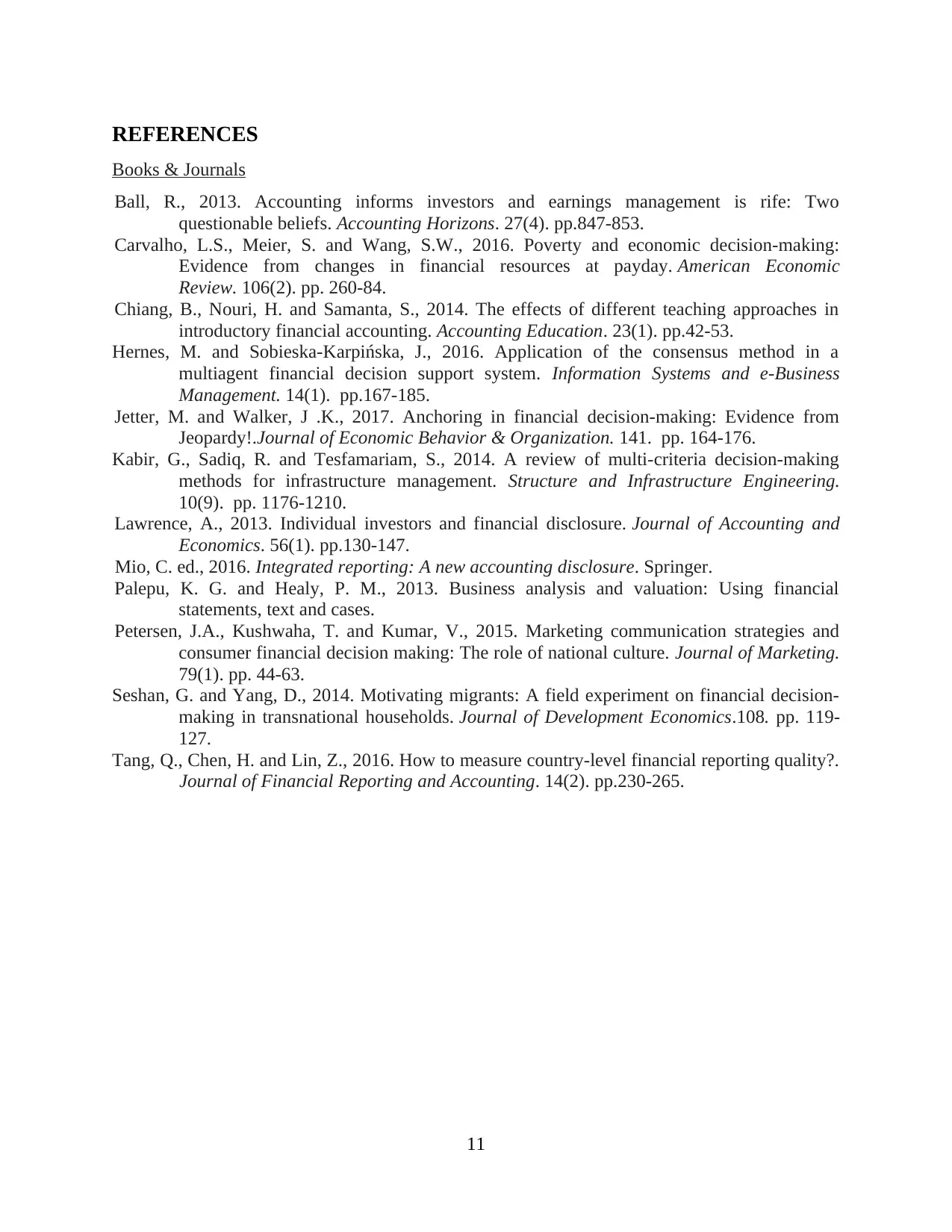
REFERENCES
Books & Journals
Ball, R., 2013. Accounting informs investors and earnings management is rife: Two
questionable beliefs. Accounting Horizons. 27(4). pp.847-853.
Carvalho, L.S., Meier, S. and Wang, S.W., 2016. Poverty and economic decision-making:
Evidence from changes in financial resources at payday. American Economic
Review. 106(2). pp. 260-84.
Chiang, B., Nouri, H. and Samanta, S., 2014. The effects of different teaching approaches in
introductory financial accounting. Accounting Education. 23(1). pp.42-53.
Hernes, M. and Sobieska-Karpińska, J., 2016. Application of the consensus method in a
multiagent financial decision support system. Information Systems and e-Business
Management. 14(1). pp.167-185.
Jetter, M. and Walker, J .K., 2017. Anchoring in financial decision-making: Evidence from
Jeopardy!.Journal of Economic Behavior & Organization. 141. pp. 164-176.
Kabir, G., Sadiq, R. and Tesfamariam, S., 2014. A review of multi-criteria decision-making
methods for infrastructure management. Structure and Infrastructure Engineering.
10(9). pp. 1176-1210.
Lawrence, A., 2013. Individual investors and financial disclosure. Journal of Accounting and
Economics. 56(1). pp.130-147.
Mio, C. ed., 2016. Integrated reporting: A new accounting disclosure. Springer.
Palepu, K. G. and Healy, P. M., 2013. Business analysis and valuation: Using financial
statements, text and cases.
Petersen, J.A., Kushwaha, T. and Kumar, V., 2015. Marketing communication strategies and
consumer financial decision making: The role of national culture. Journal of Marketing.
79(1). pp. 44-63.
Seshan, G. and Yang, D., 2014. Motivating migrants: A field experiment on financial decision-
making in transnational households. Journal of Development Economics.108. pp. 119-
127.
Tang, Q., Chen, H. and Lin, Z., 2016. How to measure country-level financial reporting quality?.
Journal of Financial Reporting and Accounting. 14(2). pp.230-265.
11
Books & Journals
Ball, R., 2013. Accounting informs investors and earnings management is rife: Two
questionable beliefs. Accounting Horizons. 27(4). pp.847-853.
Carvalho, L.S., Meier, S. and Wang, S.W., 2016. Poverty and economic decision-making:
Evidence from changes in financial resources at payday. American Economic
Review. 106(2). pp. 260-84.
Chiang, B., Nouri, H. and Samanta, S., 2014. The effects of different teaching approaches in
introductory financial accounting. Accounting Education. 23(1). pp.42-53.
Hernes, M. and Sobieska-Karpińska, J., 2016. Application of the consensus method in a
multiagent financial decision support system. Information Systems and e-Business
Management. 14(1). pp.167-185.
Jetter, M. and Walker, J .K., 2017. Anchoring in financial decision-making: Evidence from
Jeopardy!.Journal of Economic Behavior & Organization. 141. pp. 164-176.
Kabir, G., Sadiq, R. and Tesfamariam, S., 2014. A review of multi-criteria decision-making
methods for infrastructure management. Structure and Infrastructure Engineering.
10(9). pp. 1176-1210.
Lawrence, A., 2013. Individual investors and financial disclosure. Journal of Accounting and
Economics. 56(1). pp.130-147.
Mio, C. ed., 2016. Integrated reporting: A new accounting disclosure. Springer.
Palepu, K. G. and Healy, P. M., 2013. Business analysis and valuation: Using financial
statements, text and cases.
Petersen, J.A., Kushwaha, T. and Kumar, V., 2015. Marketing communication strategies and
consumer financial decision making: The role of national culture. Journal of Marketing.
79(1). pp. 44-63.
Seshan, G. and Yang, D., 2014. Motivating migrants: A field experiment on financial decision-
making in transnational households. Journal of Development Economics.108. pp. 119-
127.
Tang, Q., Chen, H. and Lin, Z., 2016. How to measure country-level financial reporting quality?.
Journal of Financial Reporting and Accounting. 14(2). pp.230-265.
11
1 out of 11
Related Documents
Your All-in-One AI-Powered Toolkit for Academic Success.
+13062052269
info@desklib.com
Available 24*7 on WhatsApp / Email
![[object Object]](/_next/static/media/star-bottom.7253800d.svg)
Unlock your academic potential
Copyright © 2020–2025 A2Z Services. All Rights Reserved. Developed and managed by ZUCOL.




